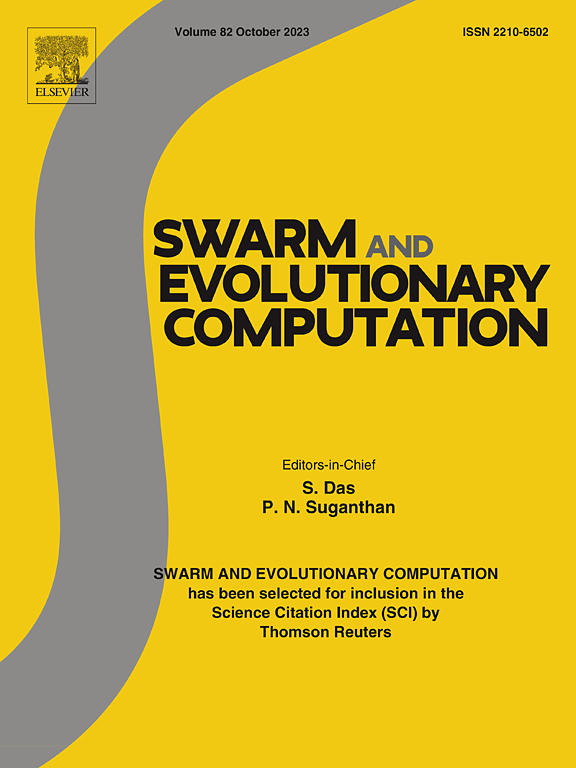一种基于偏好修正的逆代距指标的进化多目标优化算法
IF 8.5
1区 计算机科学
Q1 COMPUTER SCIENCE, ARTIFICIAL INTELLIGENCE
引用次数: 0
摘要
基于偏好的进化多目标优化算法在进化计算领域受到广泛关注。然而,结合性能指标设计基于偏好的进化算法的研究很少。本文提出了一种基于偏好修正的倒代距指标导向的进化多目标优化算法PIGA。主要目的是决策者提供他们的偏好,最终确定帕累托最优解的部分,其中位于感兴趣的区域。提出了一种基于坐标变换的偏好构建策略。将整个目标空间中的参考点投影到偏好空间中,得到首选参考点。非优选参考点保留在原始目标空间中,在指定的优选区域之外。此外,我们将候选解与首选参考点之间的距离定义为首选距离,将到非首选参考点的距离定义为惩罚距离。最后,提出了一种基于偏好的修正倒代距离指标,根据偏好和惩罚距离得到偏好最优解。通过与相关的基于偏好的进化算法在一些测试实例上的比较,对比较结果进行了综合分析。实验结果验证了该算法在给定偏好范围的不同场景下的有效性和可行性。本文章由计算机程序翻译,如有差异,请以英文原文为准。
A preference modified inverted generational distance indicator guided algorithm for evolutionary multi-objective optimization
Preference-based evolutionary multi-objective optimization algorithms have attracted much attention in the area of evolutionary computation. However, there are only a few researchers incorporating performance indicators for designing preference-based evolutionary algorithm. In this paper, we propose a preference modified inverted generational distance indicator guided algorithm, named PIGA, for evolutionary multi-objective optimization. The main purpose is that decision-makers provide their preferences, ultimately identifying the portion of Pareto optimal solutions where are located in region of interest. A new preference construction strategy based on coordinate transformation is first proposed. The reference points in the whole objective space can be projected into the preference space, obtaining the preferred reference points. The non-preferred reference points remain in the original objective space, outside the specified preference region. In addition, we define the distance between the candidate solution and preferred reference points as the preference distance and the distance to non-preferred reference points as the penalty distance. Finally, a preference-based modified inverted generational distance indicator is formulated to obtain the preferred optimal solutions according to the preferences and penalty distances. The comparative results are comprehensively analyzed by comparing it with some related preference-based evolutionary algorithms on some test instances. Experimental results have validated the effectiveness and feasibility of the proposed algorithm under different scenarios with the given preference range.
求助全文
通过发布文献求助,成功后即可免费获取论文全文。
去求助
来源期刊

Swarm and Evolutionary Computation
COMPUTER SCIENCE, ARTIFICIAL INTELLIGENCEC-COMPUTER SCIENCE, THEORY & METHODS
CiteScore
16.00
自引率
12.00%
发文量
169
期刊介绍:
Swarm and Evolutionary Computation is a pioneering peer-reviewed journal focused on the latest research and advancements in nature-inspired intelligent computation using swarm and evolutionary algorithms. It covers theoretical, experimental, and practical aspects of these paradigms and their hybrids, promoting interdisciplinary research. The journal prioritizes the publication of high-quality, original articles that push the boundaries of evolutionary computation and swarm intelligence. Additionally, it welcomes survey papers on current topics and novel applications. Topics of interest include but are not limited to: Genetic Algorithms, and Genetic Programming, Evolution Strategies, and Evolutionary Programming, Differential Evolution, Artificial Immune Systems, Particle Swarms, Ant Colony, Bacterial Foraging, Artificial Bees, Fireflies Algorithm, Harmony Search, Artificial Life, Digital Organisms, Estimation of Distribution Algorithms, Stochastic Diffusion Search, Quantum Computing, Nano Computing, Membrane Computing, Human-centric Computing, Hybridization of Algorithms, Memetic Computing, Autonomic Computing, Self-organizing systems, Combinatorial, Discrete, Binary, Constrained, Multi-objective, Multi-modal, Dynamic, and Large-scale Optimization.
 求助内容:
求助内容: 应助结果提醒方式:
应助结果提醒方式:


